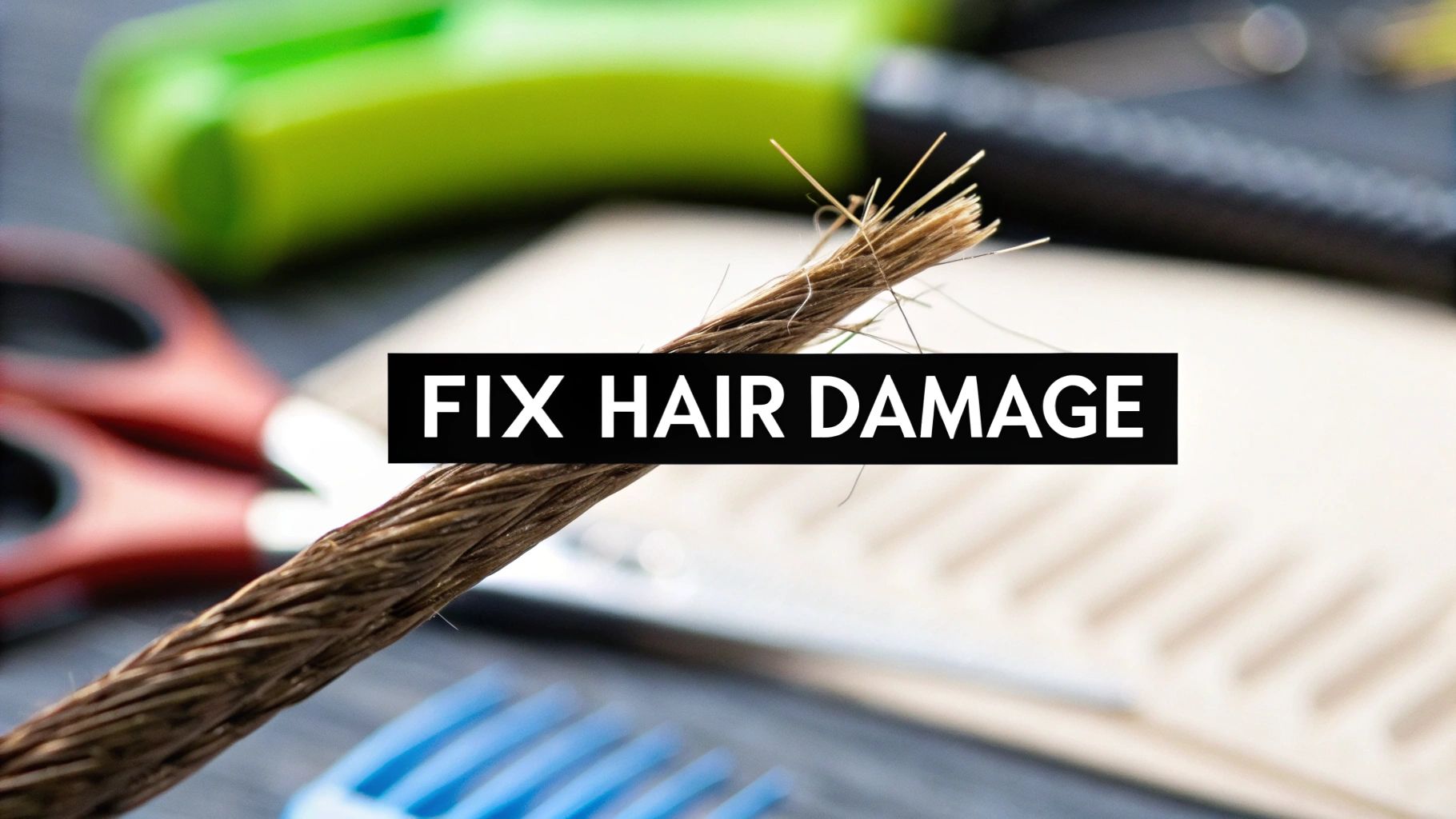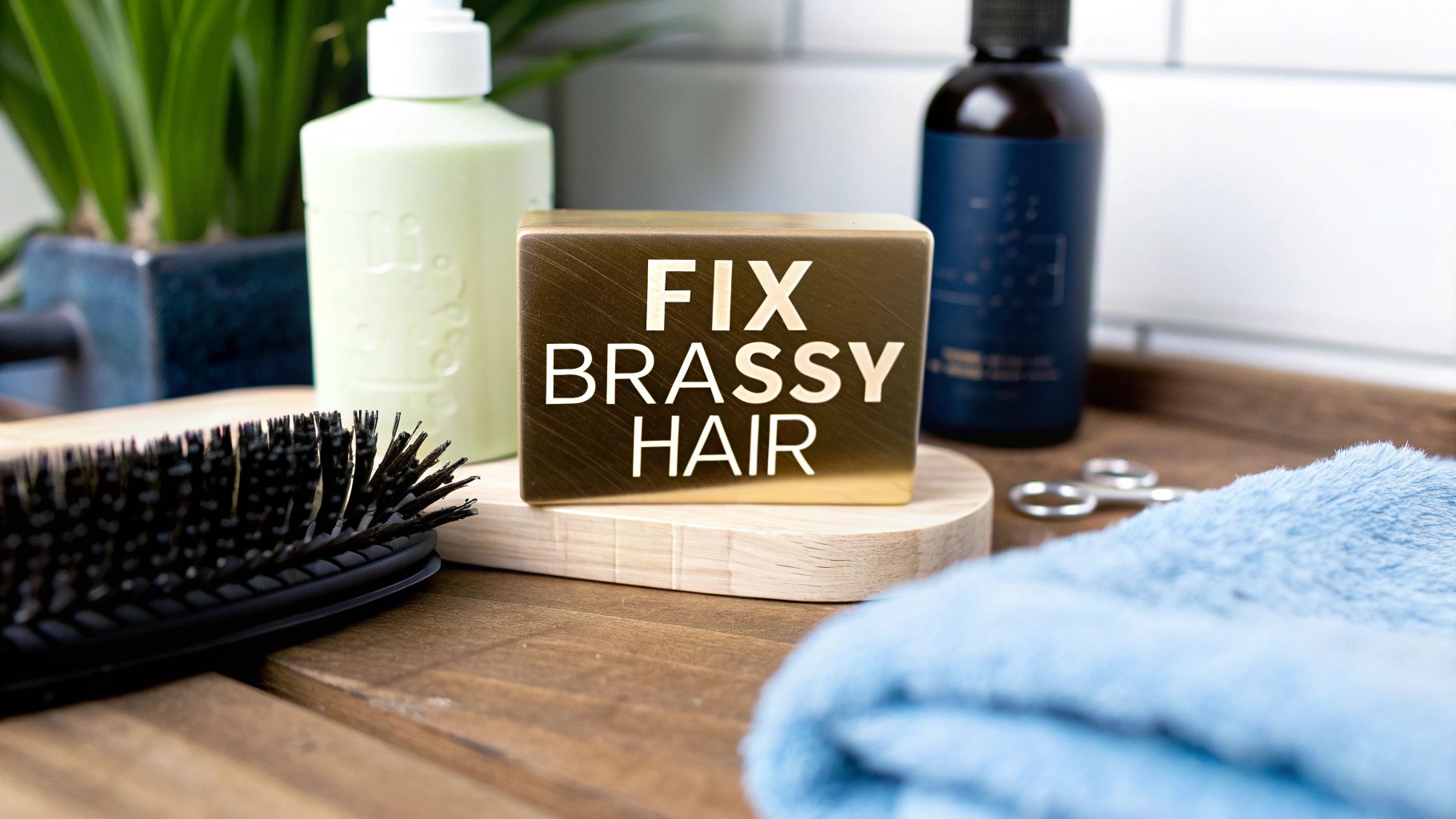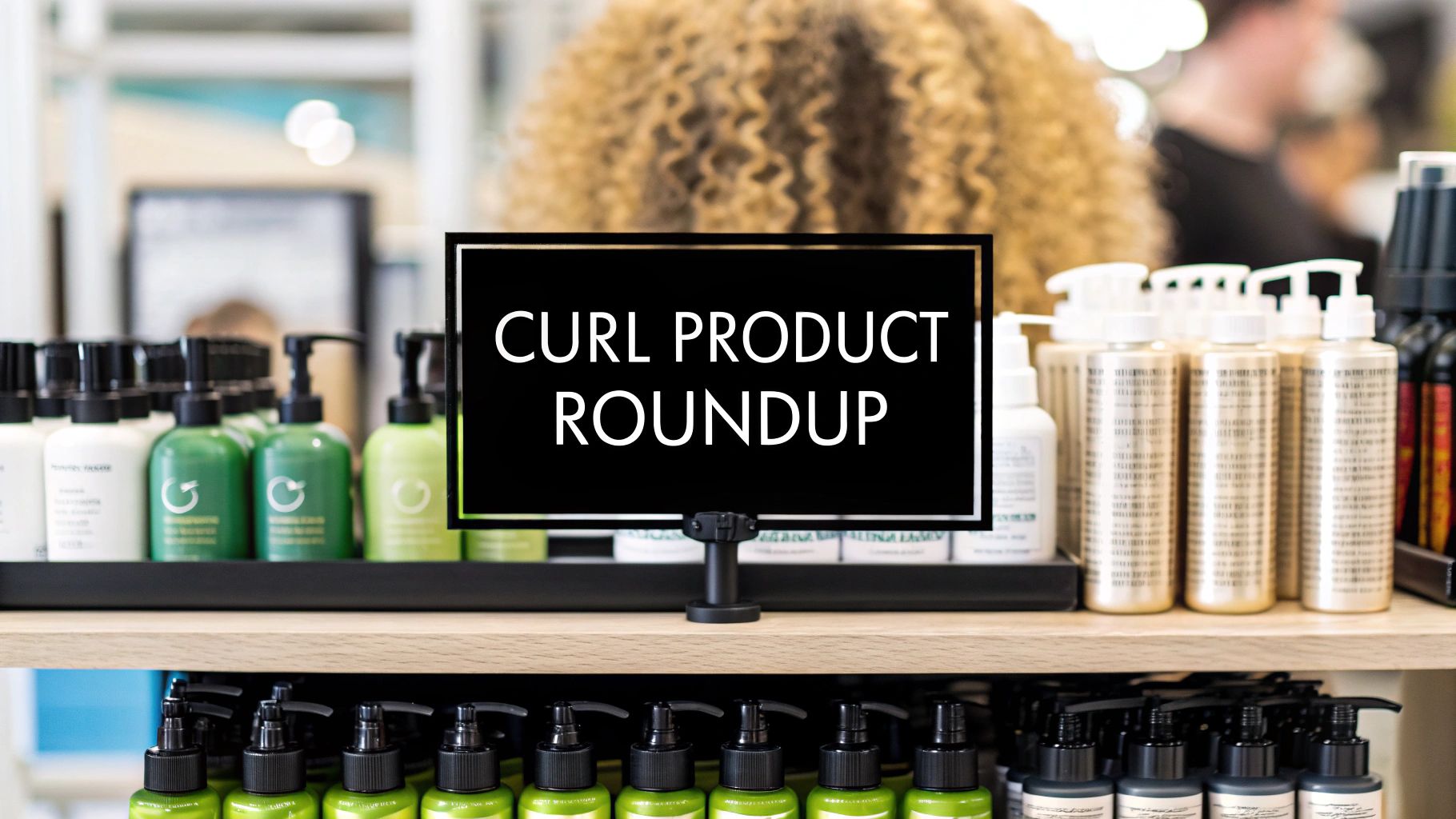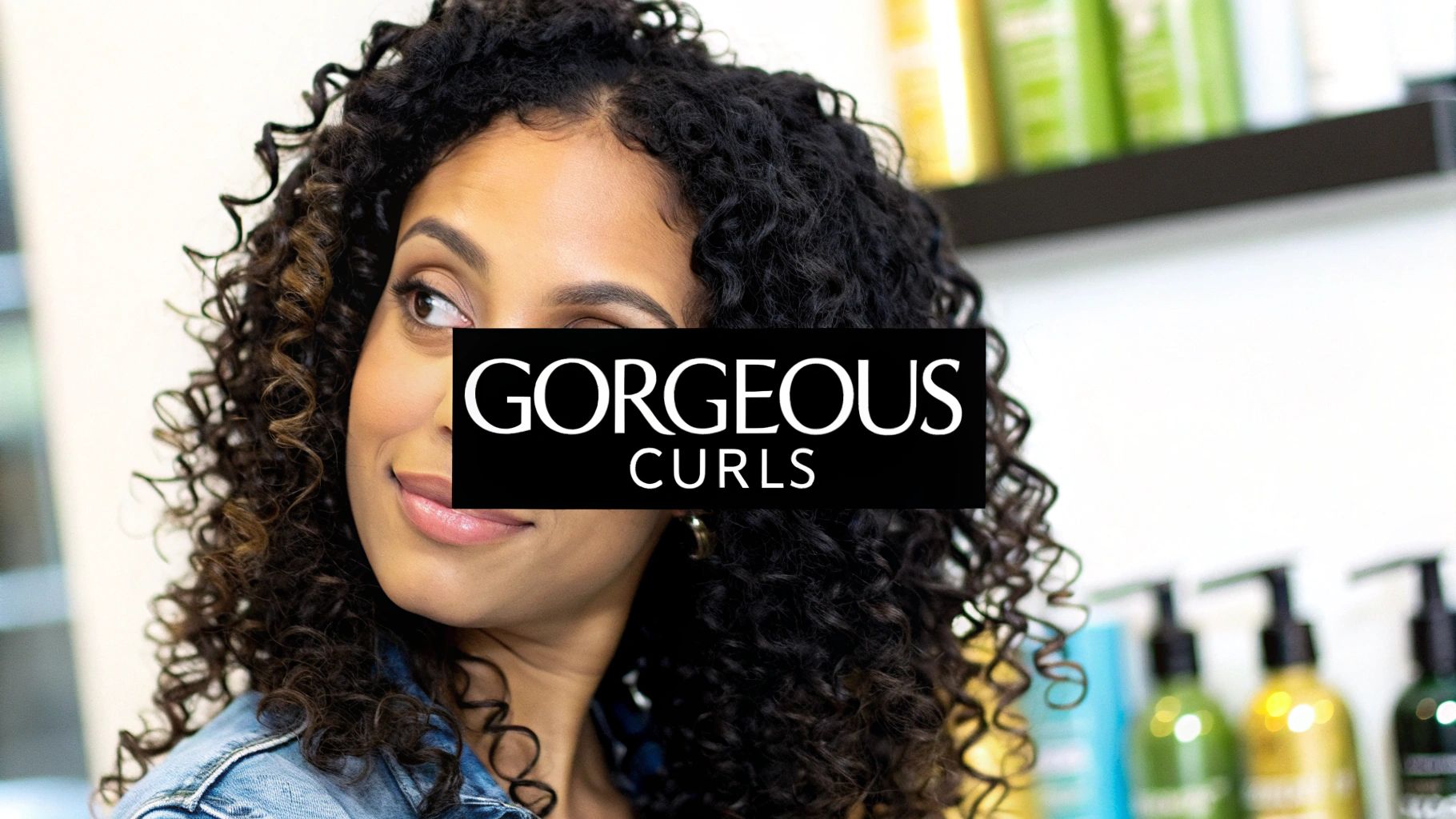We’ve all had those moments of frustration, staring in the mirror at hair that just won’t cooperate. It feels dry, looks dull, or seems to break if you just look at it the wrong way. The truth is, hair damage comes from everywhere—our daily routines, the environment, and of course, our love for heat styling and chemical treatments. Getting to the root of the problem is the only way to bring your hair back to life.
Thank you for reading this post, don't forget to subscribe!A Quick Look Inside Your Hair
Before we dive into what’s hurting your hair, let's get a clear picture of what we're trying to protect. A single strand of hair isn't just one thing; it's a complex structure with three distinct layers: the cuticle, the cortex, and (sometimes) the medulla. Each one plays a critical role in keeping your hair healthy and strong.
The First Line of Defense: The Cuticle
Think of the cuticle as your hair's personal bodyguard. It’s the outermost layer, made up of tiny, overlapping scales, a lot like shingles on a roof. When your hair is healthy, these scales lie flat and tight. This smooth surface is what reflects light, giving your hair that gorgeous shine, and it also locks in precious moisture.
This protective shield is tough, but it takes a beating from just about everything—brushing, heat, and the elements. A happy cuticle means smooth, glossy hair.
The Core of It All: The Cortex
Right beneath the cuticle is the cortex, the main event. Making up about 80% of your hair's total mass, this is where the magic happens. The cortex is packed with long keratin protein fibers that give your hair its strength, elasticity, and unique texture. It’s also where the melanin pigment lives, which dictates your natural hair color.
When the cuticle gets damaged and its scales lift up, the cortex is left exposed and vulnerable. This is where the real trouble starts—think split ends, breakage, and that dreaded brittle feeling. Most chemical services, like coloring or perming, are designed to open the cuticle to change the cortex. If you're recovering from a color session gone wrong, our guide on how to remove bleach from hair can offer some much-needed help.
The state of your hair's health comes down to the state of its cuticle. A sealed cuticle guards the inner cortex, locking in moisture and strength. A damaged, lifted cuticle is an open door to frizz, dullness, and breakage.
With this picture in mind, it’s much easier to see how damage actually happens. Whether it's a flat iron blasting the cuticle scales open or a chemical process weakening the protein bonds in the cortex, every harmful act is a direct attack on these vital layers.
Everyday Habits That Secretly Harm Your Hair
We often point fingers at the obvious culprits—harsh chemical treatments or sizzling hot tools—when our hair feels damaged. But what if I told you that some of the most persistent damage comes from the small, seemingly innocent things we do every single day?
This is what’s known as mechanical damage. It's the physical wear and tear that slowly, but surely, erodes your hair's protective outer layer, the cuticle. All that friction and tension from your daily routine chips away at your strands, eventually leading to frizz, split ends, and breakage that seems to come out of nowhere.
Imagine your hair's cuticle is like the shingles on a roof. When handled gently, they lay flat and protect everything underneath. But rough treatment—like aggressively rubbing your hair with a towel or yanking a brush through it—is like a hailstorm, lifting, cracking, and tearing those shingles away. This is especially true when your hair is wet. Water makes hair surprisingly elastic; it can stretch up to 30% of its original length, leaving it in a much weaker, more fragile state that's incredibly prone to snapping under pressure.
The Friction Factor In Your Routine
Friction is the silent saboteur of smooth, healthy hair. It’s the force at play every time your hair rubs against a surface, whether that's your cotton pillowcase while you sleep, a tight elastic band, or even the collar of your wool sweater. This constant rubbing roughs up the cuticle scales, causing them to lift and fray.
The image below gives a great visual of how different stressors, including the physical friction we're talking about, can compromise the very structure of your hair.
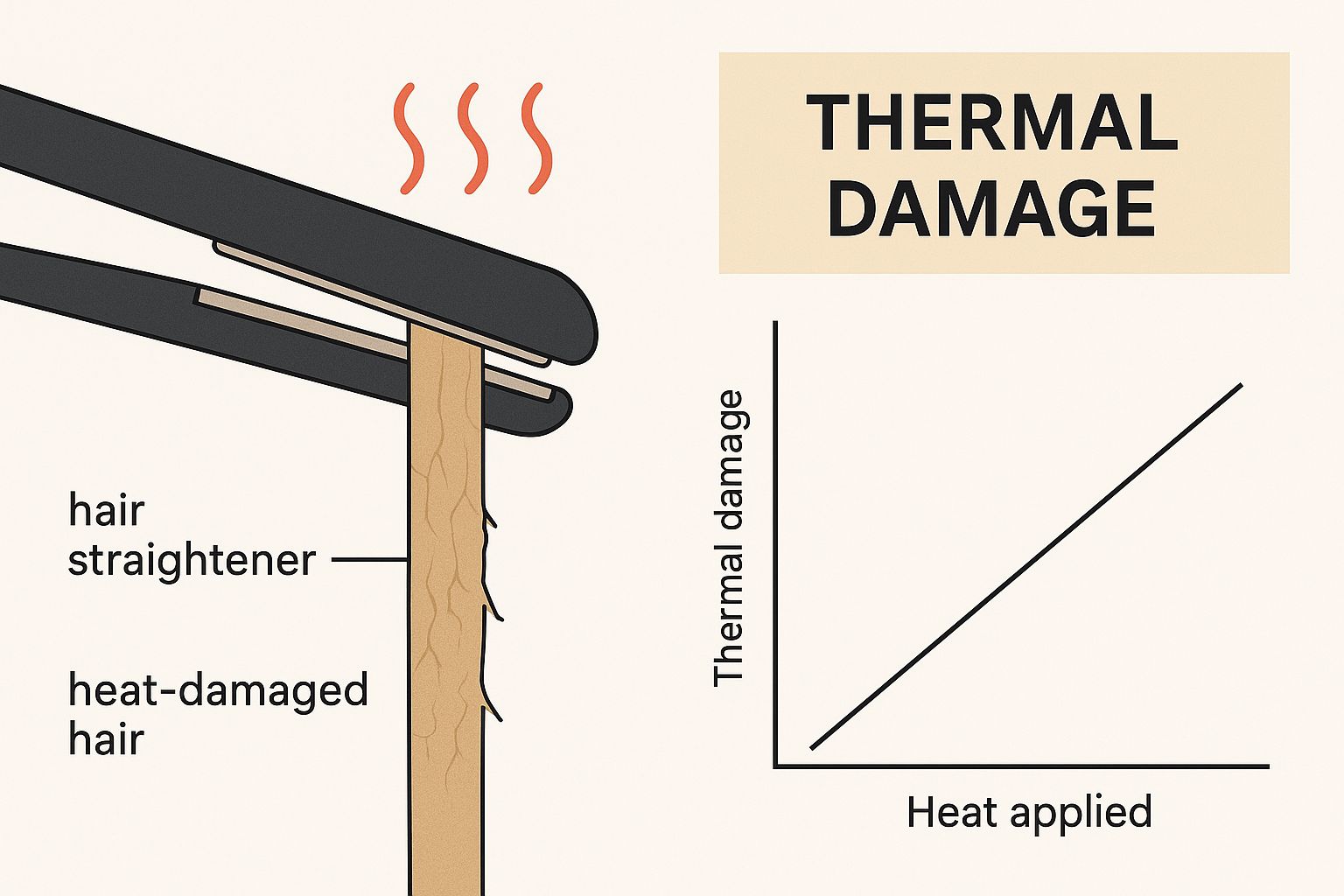
As you can see, this repeated stress literally wears down your hair's natural defenses, leaving it weak and vulnerable. The goal isn't to live in a bubble, but to consciously minimize this friction wherever you can.
Making a few simple swaps can make a world of difference. For example, sleeping on a silk or satin pillowcase allows your hair to glide across the surface, preventing the tangles and friction that a cotton case can cause overnight. It’s a small change with a big impact. Likewise, trading in your standard hair elastics for gentler accessories like scrunchies or spiral hair ties avoids creating those harsh tension points that lead to breakage.
Even the most well-intentioned routines can cause harm if not executed with care. Gentle handling is not a luxury; it's a fundamental requirement for maintaining the structural integrity of every single strand.
Smarter Swaps for Stronger Hair
Once you start seeing how your daily habits contribute to mechanical damage, you can start making smarter choices. The best part is that protecting your hair doesn't demand a massive overhaul of your life—just a few mindful adjustments.
Let's look at some common culprits and the simple, hair-friendly alternatives you can adopt today.
Common Habits vs Hair-Friendly Alternatives
| Damaging Habit | How It Harms Hair | Healthier Alternative |
|---|---|---|
| Vigorously towel-drying hair | The rough texture of a standard cotton towel creates massive friction, lifting and shredding the delicate cuticle on wet, vulnerable hair. | Gently squeeze or blot hair with a soft microfiber towel or an old cotton t-shirt. This absorbs excess water without roughing up the hair shaft. |
| Using tight, standard elastics | These create intense tension points, snagging and pulling on strands. The friction can fray the hair, leading to that tell-tale breakage right where you tie your ponytail. | Switch to silk or satin scrunchies, spiral hair ties, or claw clips. These options hold hair securely without the damaging friction and tension. |
| Brushing from root to tip | This forces the brush through tangles, creating a "ripping" effect that snaps weak strands and puts immense stress on the roots. | Start detangling from the ends and slowly work your way up to the roots using a wide-tooth comb. This gently removes knots without causing a tug-of-war with your hair. |
| Sleeping on a cotton pillowcase | Cotton fibers create friction as you move in your sleep, leading to tangles, frizz, and morning bedhead that's actually a sign of cuticle damage. | Sleep on a silk or satin pillowcase. The smooth surface allows your hair to glide, dramatically reducing overnight friction and breakage. |
By swapping out these few habits, you're not just preventing future problems—you're giving your hair a real chance to thrive. It’s about working with your hair's structure, not against it.
The Devastating Duo: Heat Styling and Chemical Treatments
If daily wear and tear slowly chips away at your hair's health, think of heat styling and chemical treatments as the heavy artillery. These are the processes that cause the most dramatic, immediate, and often profound damage. Why? Because they don't just rough up the surface; they fundamentally re-engineer your hair's structure from the inside out.
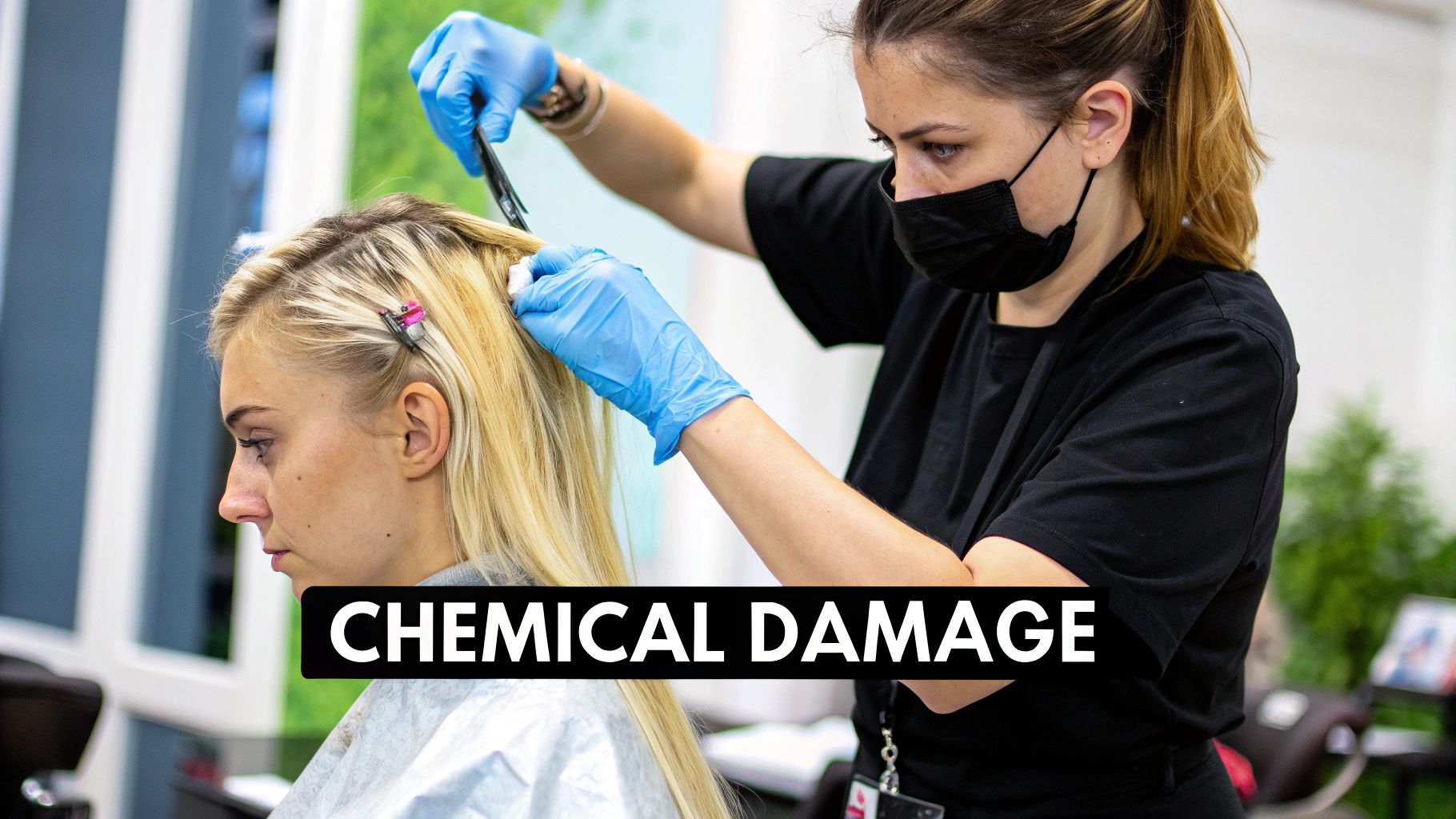
Picture a delicate silk scarf. A quick pass with an overly hot iron can leave a permanent scorch mark, and a splash of bleach will simply dissolve the fibers. Your hair, for all its strength, is just as vulnerable to these intense forces. Each blast of high heat or application of a powerful chemical formula chips away at its internal foundation, leading to a pile-up of damage that becomes incredibly hard to undo.
The Truth About Heat Styling
When you clamp a flat iron onto a section of hair or wrap it around a curling wand, you're doing much more than just setting a style. Once the temperature climbs above 350°F (177°C), something alarming happens. The water molecules inside the hair's core—the cortex—can actually flash-boil.
This creates tiny, violent bursts of steam that erupt from within the hair shaft itself. These micro-explosions are responsible for a type of damage aptly named "bubble hair," which creates cracks and voids throughout the hair's structure. The result is a permanently weakened strand that's brittle, rough, and primed to snap.
But that's not all. Extreme heat also literally cooks the keratin proteins that give your hair its elasticity and strength. The smooth, overlapping scales of the cuticle can lift, crack, or even melt away entirely, leaving the delicate inner cortex defenseless. Without that protective armor, moisture escapes freely, leaving hair perpetually dry, dull, and lifeless.
What Really Happens During Chemical Processing
Chemical services—like coloring, bleaching, perms, or relaxers—all rely on one basic principle: they have to force their way into the hair's core to work. To get past the tough outer cuticle, they employ powerful agents like ammonia or peroxide, which cause the hair shaft to swell up and pry open those protective scales like a chemical crowbar.
Once the door is kicked open, the real work begins:
- Bleaching: An oxidative process literally dissolves your natural melanin (the pigments that give hair its color). This chemical reaction is so strong that it also breaks down the essential fatty acids that keep the hair shaft strong and flexible.
- Coloring: Permanent dyes first have to bust open the cuticle and often strip some of your natural color before they can wedge new, artificial color molecules into the cortex.
- Perms and Relaxers: These treatments go even deeper, breaking the incredibly strong disulfide bonds that lock your hair's keratin structure in place. This allows your stylist to reshape the hair before applying a neutralizer to re-form some of those bonds in a new shape (curly or straight).
The problem is, once the cuticle has been forcibly opened, it never truly closes back to its original flat, smooth state.
"Every chemical service is a trade-off. You gain a new color or texture, but you sacrifice a piece of your hair's natural strength and resilience. The key is to manage this trade-off with protective measures and restorative care."
This leaves the hair permanently more porous. It acts like a sponge, soaking up and losing moisture way too quickly, which leads to frizz and tangles. It's also far more fragile and susceptible to snapping from simple brushing or styling. Without a serious commitment to bond-building treatments and deep conditioning, the damage just keeps accumulating, leaving hair with that dreaded mushy or straw-like feel.
How Environmental Stressors Weaken Your Hair
Damage isn't always about what you do to your hair. Sometimes, it’s about the world around you. Every day, your hair faces a barrage of invisible aggressors that silently chip away at its health, breaking it down strand by strand over time.
Think about how the sun can fade the paint on a car after years of sitting in the driveway. The exact same process happens to your hair. Too much sun exposure acts like a slow, relentless bleach, breaking down the crucial keratin proteins that give hair its strength and stripping away its color. This photo-damage weakens the hair from the inside out, leaving it brittle, dry, and far more likely to snap.
Invisible Threats in Your Water and Air
It’s not just the sun you have to watch out for. The very water you wash your hair with and the air you breathe can be major culprits. Hard water, for instance, is packed with minerals like calcium and magnesium.
These minerals build up on each strand, creating a film that blocks moisture from penetrating the hair shaft. This mineral buildup is a classic cause of chronic dryness, dullness, and hair that just won't cooperate.
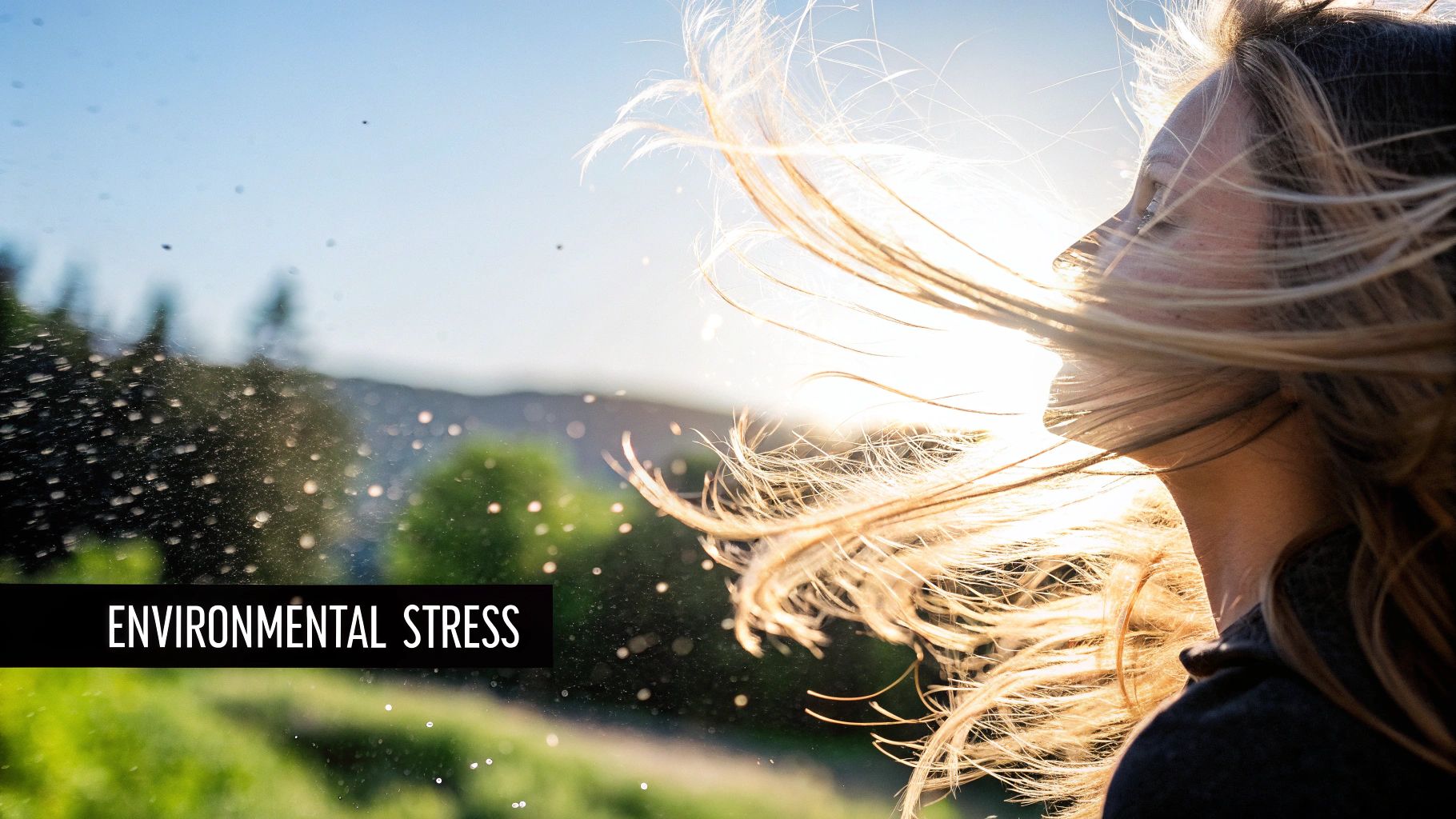
On top of that, pollutants in the air—like smoke, dust, and tiny chemical particles—settle on your hair and scalp. This creates oxidative stress, a process that unleashes damaging free radicals. These molecules attack and weaken hair’s protein structure, much like how rust corrodes metal.
The cumulative effect of environmental exposure is one of the most underestimated causes of hair damage. Protecting your hair from the sun, pollution, and hard water is just as crucial as using a heat protectant.
The Broader Impact of Environment and Lifestyle
This connection between our surroundings and our hair is a global issue. In fact, environmental exposure and lifestyle choices are major contributors to hair problems all over the world.
Take China, where about 250 million people are dealing with hair loss. Studies there have linked unhealthy habits, like regularly drinking sugary beverages, to more severe hair thinning. A shocking 60% of men in the country report hair health problems, showing just how much these factors matter. We see a similar story in India, where over 63% of men between 21 and 61 also report hair loss.
These numbers paint a clear picture: what we eat, where we live, and how we live are all deeply tied to our hair's strength. To dive deeper into this, you can explore our guide on the impact of diet on hair health.
Ready to shield your hair from these invisible threats? Here are a few simple strategies to build into your routine:
- UV Protection: Wear a hat during peak sun hours or spritz on a UV-protectant spray made for hair. Think of it as sunscreen for your strands.
- Combat Hard Water: Install a shower filter to catch harsh minerals before they reach your hair. You can also use a good clarifying shampoo once a week to wash away buildup and bring back your hair’s natural shine.
- Pollution Defense: Cleanse your hair thoroughly to remove particle buildup. Look for antioxidant-rich hair products to help neutralize free radical damage before it starts.
The Connection Between Genetics and Hair Health
While we can change our styling habits and shield our hair from the elements, some of the biggest factors in hair damage are literally written into our DNA. Genetics and hormones are the powerful, invisible forces that set the stage for your hair’s thickness, strength, and even how long it grows.
Sometimes, hair that seems weak or prone to breaking isn't just a sign of external wear and tear. It can be a direct reflection of your unique biological blueprint. This is especially true for conditions like androgenetic alopecia—what most of us know as male or female pattern hair loss. It isn't a disease; it's a natural, genetically-driven process where hair follicles just become more sensitive to hormones over time.
This sensitivity messes with the hair's natural rhythm. The growth phase gets shorter and the follicles themselves actually start to shrink. The result? The hair they produce becomes finer and weaker with each cycle. This single condition is one of the main drivers of hair concerns around the world, and your genes are a key player.
Your Genes and Hormonal Triggers
Your genes are what hand you the script for your hair's inherent traits—its texture, its density, and the length of its growth cycle. If a history of fine or thinning hair runs in your family, you’re likely more susceptible, which means your strands might be naturally more vulnerable to other kinds of damage from the get-go.
Hormonal shifts are the triggers that can bring these genetic tendencies to the forefront. Think of hormones as the directors of your hair growth cycle. When everything is in balance, the show runs smoothly. But when a major hormonal shift occurs, it can throw the whole system off, pushing way more hairs into the resting (telogen) phase than usual. That’s when you start to see noticeable shedding and thinning.
A few major life events are notorious for triggering these hormonal shifts:
- Pregnancy and Postpartum: During pregnancy, a surge in estrogen often gives you that amazing, thick hair. But after childbirth, those estrogen levels take a nosedive. This sudden drop can send a huge number of hairs into the shedding phase all at once, leading to postpartum hair loss.
- Menopause: As estrogen and progesterone levels decline, hair can start to grow more slowly and become much finer. This hormonal change can either unmask or speed up an underlying predisposition for androgenetic alopecia.
- Thyroid Conditions: Your thyroid is a master regulator. If it’s overactive (hyperthyroidism) or underactive (hypothyroidism), the disruption can lead to diffuse hair loss all over your scalp.
Understanding your own genetic and hormonal landscape is key. It helps you figure out what you can control with lifestyle changes versus what might be an underlying condition that needs a specialist's attention.
Just how common is this? Androgenetic alopecia accounts for a staggering 95% of hair loss cases worldwide. The numbers show that about 85% of men and 33% of women will face it at some point in their lives. And it's no surprise that 70.5% of people with the condition report having a family history of it. You can explore more global hair loss statistics on Medihair.com to see the full picture.
Your Action Plan for Repairing Damaged Hair
Okay, so now you know why your hair is damaged. But what do you do about it? The next step is creating a recovery plan, and it's less about a total life overhaul and more about making a few smart, strategic shifts in your routine.
Think of it as a two-pronged attack: we need to protect the new, healthy hair growing in while we work on mending the older, damaged strands.
The first, and maybe most important, change starts in the shower. Ditch the harsh detergents and switch to a sulfate-free shampoo and a deeply hydrating conditioner. Sulfates are fantastic at cleaning, but they’re too good—they strip away the natural oils your fragile hair desperately needs, leaving it even drier and more prone to snapping.
Choosing Your Treatment: Moisture or Protein?
Once you’ve got your gentle cleansing routine down, it’s time to bring in the heavy hitters: targeted treatments. The trick is figuring out what your hair is actually craving. Is it thirsty or is it weak?
-
Moisture Treatments: If your hair feels brittle, crunchy, or just plain straw-like, it's begging for moisture. Look for deep conditioners and masks packed with ingredients like hyaluronic acid, glycerin, or natural oils to bring back that soft, flexible feeling.
-
Protein Treatments: On the other hand, if your hair feels limp, gummy, or overly stretchy (almost like a wet noodle), its internal structure has been compromised. This is where protein comes in. Treatments with ingredients like keratin and amino acids act like spackle, patching up the weak spots in the hair shaft to restore its core strength.
A word of caution: using the wrong one can backfire. Pumping protein into hair that’s just dry can make it even more brittle and stiff.
Here's a simple way to think about it: Moisture gives your hair flexibility and stretch. Protein gives it structure and strength. Healthy hair needs a perfect balance of both to handle everything you throw at it.
Bring in the Bond Builders
If your damage comes from heat styling or chemical processing, bond-repairing products are non-negotiable. These aren't just conditioners; they work on a molecular level to actually rebuild the broken disulfide bonds that give your hair its structural integrity.
Heat is a huge culprit here, and if that’s your main issue, you can find a more detailed recovery guide on how to repair damaged hair from heat.
The good news is that you’re not alone in this fight. Consumers are getting smarter about hair health, and the industry is responding. The global hair care market is expected to jump from USD 96.7 billion in 2025 to a whopping USD 128.7 billion by 2034.
This growth is largely fueled by people like you seeking out products that don't just mask damage, but actively repair and prevent it. You can see more about this growing market on Market.us. This shift means it's easier than ever to find truly effective, science-backed solutions for your hair.
We've covered a lot of ground on what causes hair damage, but I know you probably still have some specific questions buzzing around. Let's tackle a few of the most common ones I hear from clients all the time.
"Is It Possible to Genuinely Repair Damaged Hair?"
This is the big one, and the honest answer is a little nuanced. Since hair isn't living tissue, you can't "heal" a damaged strand in the same way a cut on your skin heals.
But that doesn't mean you're stuck. Think of it less like healing and more like mending a favorite piece of clothing. You can't un-rip the fabric, but you can skillfully patch it up to make it strong, functional, and beautiful again. That’s exactly what modern hair treatments do.
Formulas with bonding agents, keratin, and ceramides act like a high-tech glue, filling in the cracks and patching the potholes along your hair's cuticle. They seal everything down, which dramatically improves the look and feel of your hair and, most importantly, prevents a small problem from becoming a big one. The best approach is always a two-parter: protect the new, healthy hair growing in, while using these amazing treatments to manage and support your existing length.
"How Often Should I Really Be Washing My Hair?"
There’s no magic number here, and anyone who tells you otherwise isn't considering your unique hair. The perfect washing schedule comes down to your hair type, your scalp's oil production, and your daily life.
Washing too often can strip away the natural, protective oils (sebum) your scalp produces, leaving your hair dry, brittle, and vulnerable. On the flip side, not washing enough can lead to buildup on the scalp, which can clog follicles and get in the way of healthy new growth.
For most people, washing 2-3 times a week with a high-quality, sulfate-free shampoo strikes the perfect balance. If your scalp is naturally oily or you hit the gym every day, you might need to wash more often—just be sure to use an extra-gentle cleanser.
"Does Getting a Trim Actually Make My Hair Stronger?"
A haircut won't change the biological structure of the hair growing out of your scalp, but it is absolutely essential for keeping your hair strong from top to bottom. The real enemy here is the split end.
Once a split starts, it acts like a run in a stocking—it will just keep traveling up the hair shaft, causing more and more damage along the way. A regular trim snips off those weakened, split ends before they have a chance to wreak havoc.
Think of trims every 8-12 weeks as your best line of defense. By proactively removing the most fragile parts of your hair, you stop breakage in its tracks and keep your hair looking full and healthy.
At Hairicc, our expert stylists specialize in creating personalized care plans to restore and protect your beautiful curls. Book your consultation today to start your journey toward healthier, stronger hair.
